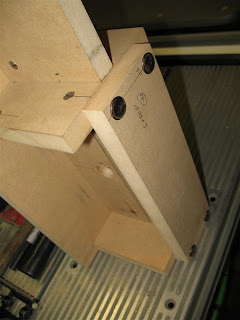Each piece of MDF is ridiculously heavy. But it cuts glassy smooth. I used a Red Devil 7" narrow kerf carbide blade, which cuts with excellence. Having created my cut list for all the MDF components, I took my table saw to the hangar for some precision cutting. No sawdust here. Only microfine dust which is electrostatically charged and migrates everywhere. Kind of a preview of coming attractions for what a colossal mess you will be able to make with the router when you CNC MDF. One cool thing with SolidWorks is it is really easy to take an assembly apart. The following photo shows all the parts.
The way I draw, I create the basic stock component size, so I can look at the part, roll it back to the 1st step and know how big a piece of material will be required. I can also create an assembly to nest these parts for efficiency.
In this case I did not nest, but I cut the largest parts out first in order of descending size. The table was the largest and had quite a bit of leftover which I made some of the smaller parts from. I purchases the table piece last year and created it outdoors (earlier photos). So I loaded up the table saw and brought it to the hangar. The floor is very flat, it is heated and it was very cold outside here in Montana at that time. The table saw is a Ryobi BT-3000 Cutting System. I went hog wild purchasing every accessory sold for the table at the time (15 years ago).
 |
| Table saw set-up |
The saw is quite lightweight (nice), disassembles for transport and has the folding exit table extension, fence extension, side table extension kit, wheel kit, accessory table kit, miter arm kit, and am/fm/cd/8-track :-) And I have a couple of Harbor Freight roller stands to help also. I tried to only work from the front, as I could see the dust was accumulating very quickly and deeply at the rear as the parts stacked up. One of the kids was going to 'help' me clean up and I am glad I headed him off at the pass. I was able to very controlledly sweep the mess up without creating a dust storm (more) and used the vacuum to get the remainder up. But next time this will need to be done outdoors. The dust was confined to only the nearest six feet, and the aircraft parts within this range were able to be cleaned up with only a damp rag.. But if there was a breeze of any kind, there would have been a nightmare of dust coating EVERYTHING. So a dust handling system will be a must have, and I have already begun building from a quality planset I got from eBay. I cut the parts with a tolerance of about the width of a tape measure mark (a few thousandths), but certainly less than 1/32 of an inch.
 |
| Some typical parts sized to match |
 |
| View of match part across the top |
 |
| View of matched parts down ends-good tolerance for a table saw |
Keep in mind that this is only the basic outside dimensions of each part, which most will require further post-processing of hole drilling and profiles creating.
To give you an idea of mess I was creating, see this photo:
 |
| High view of set-up and mess |
 |
| Closer view of dust output |
 |
| Amazing how the floor disappears |
But, I got all the parts cut, so I carefully transported them and the saw home again. Here is a view of the finished pile:
 |
| Finished pile (near) |
All the table base support parts, gantry parts, carriage parts and Z-axis router support parts are here.
 |
| 'Scrap' on left< >Parts on right |
 |
| Near pile and big piece is 'scrap' (for other projects) |
 |
| Scrap pile |
 |
| The Parts-now all will need more work |
Notice all the parts are labelled-each looks like the next, so in case of an avalanche, I will be able to sort it all out. Load 'em up, Move 'em out!























































